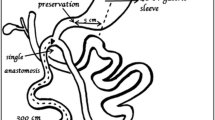Abstract
Background
To date, few studies have examined the effect of morbid obesity on the outcome of laparoscopic antireflux surgery and results have been conflicting. The aim of this work was to study the outcome of laparoscopic Nissen fundoplication (LNF) in patients with body mass index (BMI) ≥ 35.
Methods
We prospectively followed 70 patients (15 men, 55 women) with a proven diagnosis of gastroesophageal reflux disease (GERD) and a mean BMI of 38.4 ± 0.5 (range, 35–51) who underwent LNF. All patients underwent 24-h pH study, esophageal manometry, upper gastrointestinal (GI) endoscopy, and GERD symptom score before and 6 months after LNF. Surgical outcomes were compared to those of 70 sequential nonobese patients (BMI < 30) who also underwent LNF.
Results
LNF was completed laparoscopically in 69 of 70 patients in the morbidly obese (MO) group and in all 70 patients in the normal-weight (NW) group. The mean operative time for the MO group was not significantly longer than that for the NW group (55.9 ± 2.3 min vs 50.0 ± 2.1 min), but the mean length of stay was significantly longer (3.17 ± 0.2 days vs 2.2 ± 0.1 days, p < 0.0001) in the MO group. There was one postoperative complication (a transhiatal herniation of the stomach) in the morbidly obese group. In both patient groups, LNF resulted in a significant increase in lower esophageal sphincter (LES) pressures. This was associated with a significant decrease in percent acid reflux in 24-h testing and a significant improvement in GERD symptom score in both groups, although patients in the MO group had a significantly higher mean reflux symptom score after surgery than did those in the NW group. After a mean follow-up of 41.6 ± 2.9 months, one patient in the MO group required reoperation and one proton pump inhibitor therapy (PRN PPI), as required.
Conclusions
Morbid obesity does not adversely affect the outcome of LNF. The conversion rate is low when performed by an experienced surgeon.


Similar content being viewed by others
References
Allen CJ, Parameswaram K, Belda J, Anvari M (2000) Reproducibility, validity, and responsiveness of a disease-specific symptom questionnaire for gastroesophageal reflux disease. Dis Esophagus 13: 265–270
Anvari M, Allen C (1998) Laparoscopic Nissen fundoplication: two-year comprehensive follow-up of a technique of minimal paraesophageal dissection. Ann Surg 227(1): 25–32
Campos GM, Peters JH, DeMeester TR, Oberg S, Crookes PF, Tan S, DeMeester SR, Hagen JA, Bremner CG (1999) Multivariate analysis of factors predicting outcome after laparoscopic Nissen fundoplication. J Gastrointest Surg 3: 292–300
Fasol R, Schindler M, Schunmaker B (1992) The influence of obesity on perioperative morbidity: retrospective study of 502 aortocoronary bypass operations. Thorac Cardio Surg 40: 126–129
Flancbaum L, Choban PS (1998) Surgical implications of obesity. Ann Rev Med 49: 215–234
Foley K, Lee RB (1990) Surgical complications of obese patients with endometrial carcinoma. Gynecol Oncol 39(2): 17–4
Fraser J, Watson DI, O’Boyle CJ, Jameson GG (2001) Obesity and its effect on outcome of laparoscopic Nissen fundoplication. Dis Esophagus 14(1): 50–53
Hahnloser D, Schumacher M, Calvin R, Cosendey B, Petropoulos P (2002) Risk factors for complications of laparoscopic Nissen fundoplication. Surg Endosc 16: 43–47
Kulig M, Nocon M, Veith M, Leodolter A, Jaspersen D, Labenz J, Meyer-Sabellek W, Stolte M, Lind T, Malfertheiner P, Willich SN (2004) Risk factors of gastroesophageal reflux disease: methodology and first epidemiological results of the ProGERD study. J Clin Epidemiol 57(6): 580–589
Leon SM (1999) Obesity. Nutr Hosp 14(2): 92S–104S
Locke GR 3rd, Talley NJ, Fett SL, Zinsmeister AR, Melton LJ 3rd (1999) Risk factors associated with symptoms of gastroesophageal reflux. Am J Med 106(6): 642–649
McNatt SS, Smith CD, Hunter JG, Galloway KG (2000) Morbid obesity does not predict a poor outcome after laparoscopic antireflux surgery (abstr). Gastroenterol 118: A1033
Perez AR, Moncure AC, Rattner DW (2001) Obesity adversely affects the outcome of antireflux operations. Surg Endosc 15(9): 986–989
Postlethwait RW, Johnson WD (1972) Complications following surgery for duodenal ulcer in obese patients. Arch Surg 105: 438–440
Riou JA, Cohen JR, Johnson H (1992) Factors influencing wound dehiscence. Am J Surg 163: 324–330
Winslow ER, Frisella MM, Soper NJ, Klingensmith ME (2003) Obesity does not adversely affect the outcome of laparoscopic antireflux surgery (LARS). Surg Endosc 17: 2003–2011
Author information
Authors and Affiliations
Corresponding author
Additional information
Presented at the Society of American Gastrointestinal and Endoscopic Surgeons (SAGES) meeting, Los Angeles, CA, USA, 12–15 March 2003
Rights and permissions
About this article
Cite this article
Anvari, M., Bamehriz, F. Outcome of laparoscopic Nissen fundoplication in patients with body mass index ≥35. Surg Endosc 20, 230–234 (2006). https://doi.org/10.1007/s00464-005-0031-y
Received:
Accepted:
Published:
Issue Date:
DOI: https://doi.org/10.1007/s00464-005-0031-y




